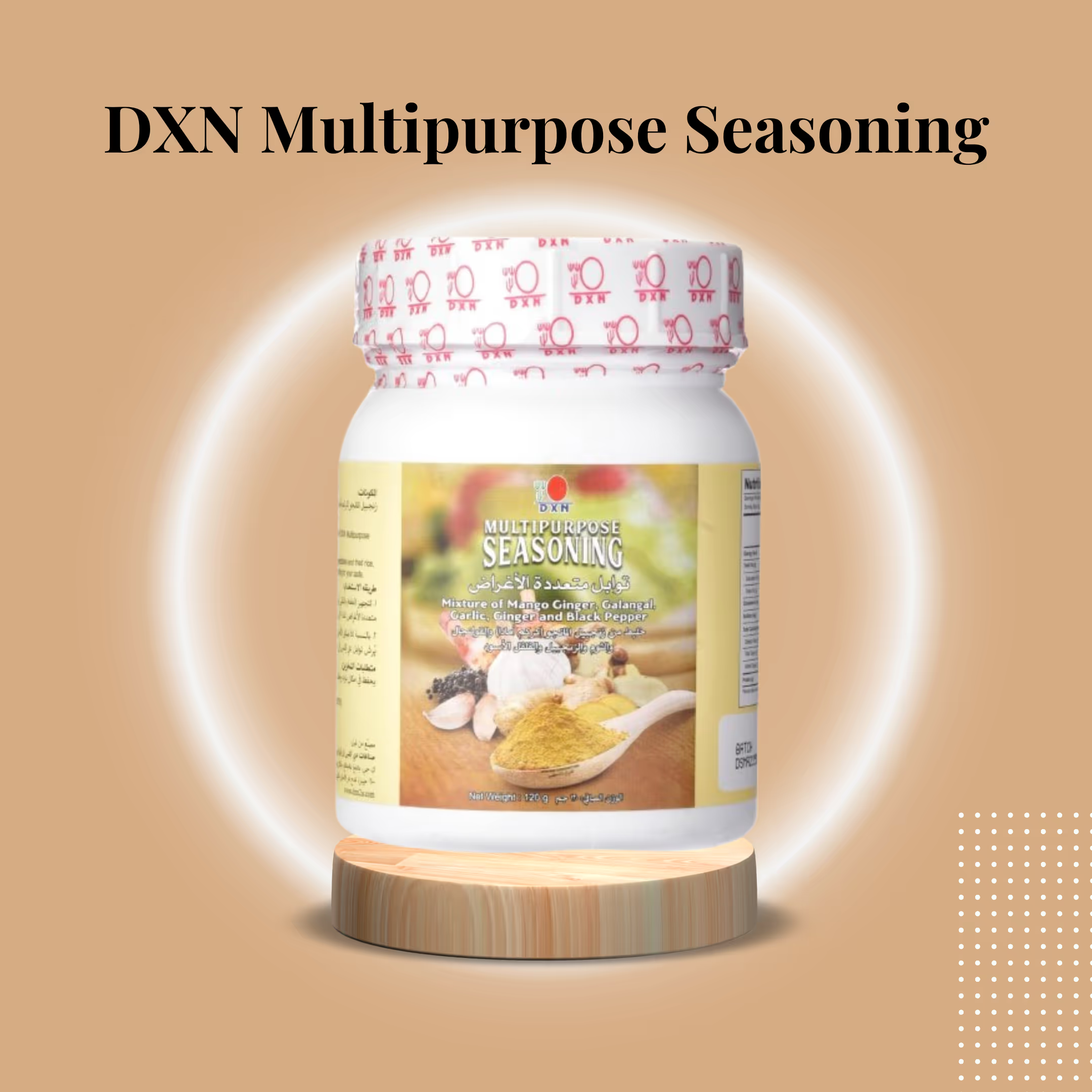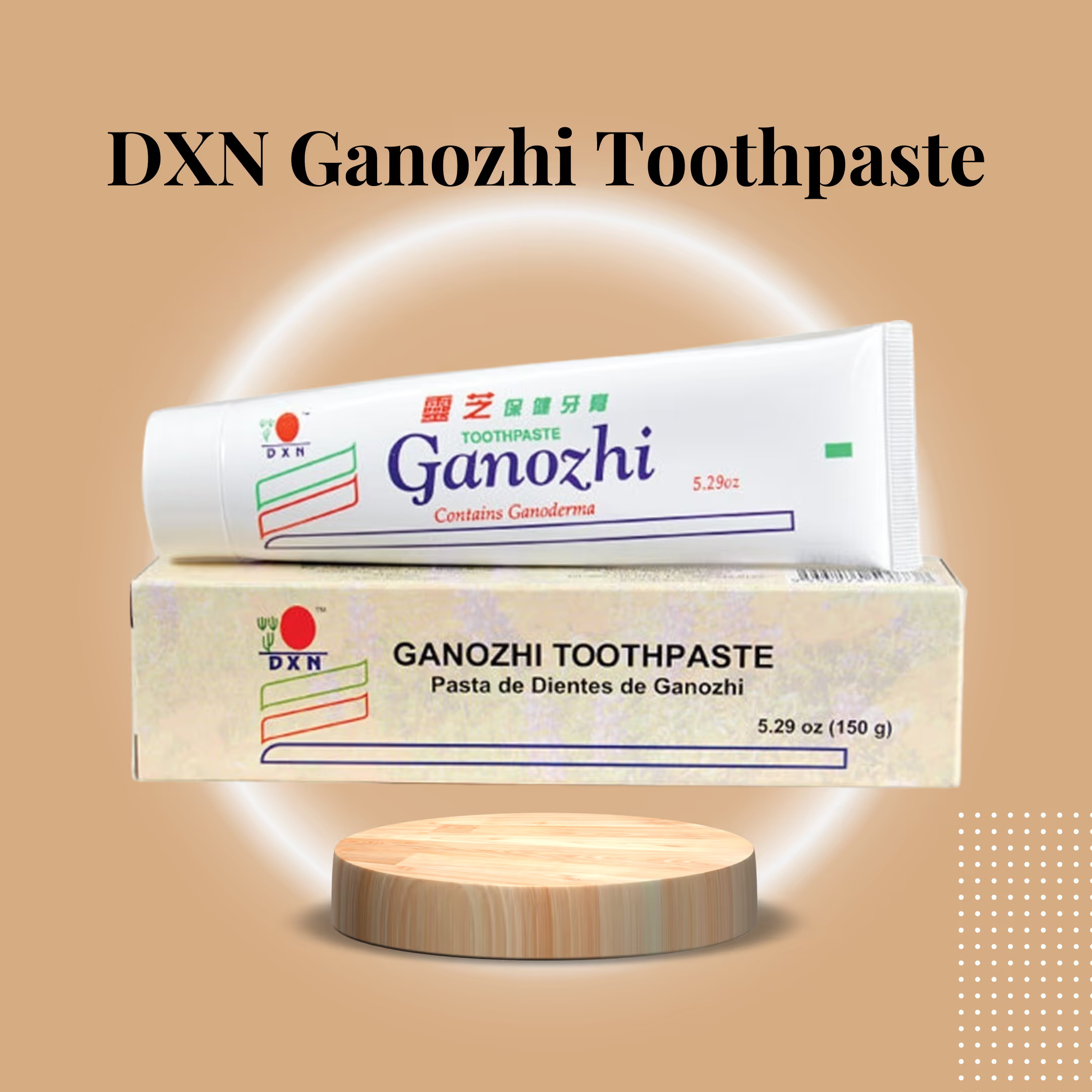The clean-flavor movement: why seasoning matters
Flavor is the bridge between nutrition and enjoyment. Historically, rich flavor required time, high-quality ingredients, and culinary skill—think long braises, homemade stocks, and caramelized vegetables. Modern convenience foods short-circuit that process by relying on flavor shortcuts, such as refined sugars, inexpensive fats, and concentrated flavor enhancers. Those methods create instant gratification, but often at the cost of nutrition transparency and long-term health.
Clean eaters want the best of both worlds: intense, layered flavor and full label honesty. That’s why a seasoning that delivers true savory depth without added sodium, sugar, artificial agents or hidden glutamates is more than a convenience item—it’s a kitchen strategy for mindful cooking.
What DXN Multipurpose Seasoning is (and isn’t)
DXN Multipurpose Seasoning is a concentrated spice blend, free from added salt and sugar, based on aromatic root ingredients and black pepper. It uniquely combines mango ginger, galangal, garlic, and black pepper for a flavor described as pungent, floral, peppery, and slightly fruity. The blend avoids fillers, instead utilizing botanical oils and natural enzymes from roots to achieve its distinctive taste.
What it is not:
- It is not a pre-salted rub or a sugar-sweetened coating.
- It is not a product that contains free glutamate-rich extracts, such as hydrolyzed vegetable protein, autolyzed yeast, or yeast extract.
- It is not a medical product—its role is culinary and supportive, not therapeutic.
This makes the seasoning ideal for cooks who want complete control over sodium and caloric intake while still achieving a restaurant-worthy flavor boost.
Ingredient spotlight: the roots and why they matter
Mango ginger (Curcuma amada)
Often overlooked outside South Asia, mango ginger has a scent that combines the notes of green mango with the warm spiciness of ginger. Beyond aroma, it brings:
- Natural digestive-support compounds (traditional sources cite enzymes that aid protein breakdown).
- Anti-inflammatory and antioxidant properties are commonly associated with rhizomes.
Culinary use: adds brightness and slightly tangy, aromatic complexity—excellent in marinades and sauces.
Galangal (Alpinia galanga)
Galangal is closely related to ginger and turmeric, but tastes brighter, more resinous, and peppery. It’s a staple in Southeast Asian cooking for a reason:
- High antioxidant profile (polyphenols, flavonoids) that contributes both to palate depth and nutritional value.
- Traditional uses include easing digestive upset and calming inflammation.
Culinary use: foundational flavor in broths, curries, and grilled rubs where you want a complex background note that isn’t bitter.
Common ginger
Ginger’s warming, pungent character stimulates the production of saliva and digestive secretions. It:
- Helps ease nausea and supports digestion.
- Provides spicy warmth that amplifies other roots in the blend.
Culinary use: Use early in cooking to bloom its oils or add at the end for fresh zing.
Garlic
A universal savory anchor—garlic’s sulfurous compounds give dishes meaty depth and umami-like satisfaction without any engineered glutamates. It:
- Contains antimicrobial compounds and has a long-standing culinary utility.
Culinary use: works in everything—marinades, sauces, vegetable sautés.
Black pepper (piperine)
Black pepper is the functional bridge ingredient:
- Piperine enhances the bioavailability of other plant compounds, helping you absorb more of the antioxidants and phytonutrients found in the roots.
- It adds the right selective heat, rounding out the flavor profile.
Together, these ingredients create an aromatic matrix—encompassing taste, scent, and mouthfeel—that reads as full-bodied and savory, often perceived as “meaty” or “umami-rich” without the addition of glutamates.
Natural umami vs. MSG: what’s the difference and why it matters
Umami is the savory taste we crave. It’s stimulated by certain amino acids and nucleotides found naturally in foods—think ripe tomatoes, aged cheeses, mushrooms, and slow-browned stock. MSG is the sodium salt of glutamic acid designed to deliver an intense, focused umami hit.
Here’s the practical distinction for cooks:
- Natural umami from whole ingredients offers complexity, not just intensity. It interacts with fats, acids, and bitter notes, producing a layered finish.
- MSG supplies immediate savory gain but lacks the aromatic complexity and texture that come from whole foods. It’s also often delivered with high sodium.
- Many products labeled “no MSG” still contain ingredients such as hydrolyzed vegetable protein or yeast extracts. These ingredients naturally contain high levels of free glutamate, which can produce the same sharp umami effect as added MSG while still being considered “natural.” To avoid all forms of concentrated free glutamates, you must carefully examine the product ingredient labels.
DXN Multipurpose Seasoning creates a whole-food umami taste by using aroma-rich roots for depth, enzymes in cooking to release flavors, and piperine to enhance absorption—delivering the fifth-taste sensation without engineered glutamates.
Functional benefits you get when you season with roots
This seasoning functions as a culinary tool with supportive wellness advantages—measured, realistic, and reliable.
Digestive support
- Ginger and mango ginger stimulate digestive juices and can help relieve bloating and mild cramping. Their enzyme activity can assist protein digestion when incorporated into meals.
Antioxidant and anti-inflammatory contributions
- Galangal and ginger are rich in polyphenols, which act as antioxidants. Regular culinary use supplies small but meaningful doses of these compounds—part of a lifestyle strategy that favors a steady intake of phytonutrients.
Improved nutrient uptake
- Black pepper’s piperine helps your body extract more benefit from the other plant compounds and can, in some cases, improve the absorption of nutrients in the same meal.
Calorie and sodium control
- Because the mix contains no added sugar or salt, it enables cooks to craft flavorful dishes while controlling caloric density and sodium, which are key for individuals managing hypertension or reducing sugar in their diet.
These are supportive benefits—not cures—and they compound over time as part of a varied, balanced diet.
Why does the lack of added salt and sugar matter in practice
Many “all-purpose” mixes rely heavily on salt and sugar to achieve mass appeal. That’s handy for manufacturers, but it leaves consumers with reduced control over their macros and sodium intake.
By removing added salt and sugar:
- You decide the final sodium and caloric content. Add sea salt or Himalayan pink salt to taste, or opt for a low-sodium option for sensitive guests.
- The seasoning becomes more versatile. Use it to flavor fruit-based salads, low-sodium soups, or sauces for people on restricted diets.
- You avoid the “hidden calories” that come from sugar in many commercial blends.
This philosophy aligns with mindful cooking: flavor first, but not at the expense of health.
Cooking with DXN Multipurpose Seasoning: practical techniques
Here are ways to get the most from a root-based, salt-free seasoning:
Bloom early
Heat a small amount of oil and add the seasoning early while sautéing onions, garlic, or aromatics. Heat helps volatile oils release and distributes the flavor throughout the dish.
Build layers
Use the seasoning at multiple stages: in a marinade, in the pan, and as a finishing sprinkle. Because it lacks salt, you’ll be tasting flavor rather than salinity at every step.
Use as a rub
For roasts, meats, or tofu — coat with a little oil, rub on the seasoning, and allow time to penetrate (30–60 minutes or overnight). The roots will flavor deeply when heat is applied.
Reinvent stocks and broths.
A spoonful in vegetable stock or instant broths transforms the base, giving it an authentic, simmered quality without added monosodium glutamate or bouillon powders.
Plant-based applications
Sprinkle on roasted vegetables, stir into lentil stews, or add to bean-based spreads to create savory, satisfying vegetarian dishes that read as “meaty” without meat.
Salt strategy: how to season mindfully
Because the mix contains no salt, adopt this sequencing for balanced results:
- Sear and build flavor: use the seasoning with aromatics early to bloom oils.
- Simmer: allow the flavors to integrate in liquid-based dishes.
- Taste: at the end, adjust salinity with a mineral-rich salt (Himalayan pink, sea salt) or low-sodium soy/tamari if you want umami.
- Finish with acid: a squeeze of lemon or a splash of vinegar brightens the roots and delivers a perceived reduction in salt—acid can make food taste balanced with less sodium.
This approach gives you total control and often results in lower overall salt while maintaining a full-flavored plate.
Pairings and menu ideas
- Stir-fries: start with oil, briefly bloom the seasoning, then add vegetables and protein. Finish with a dash of sesame oil.
- Marinades: combine seasoning with citrus juice, oil, and a touch of honey (optional) for chicken or firm fish.
- Soups and broths: 1–2 teaspoons dissolved into stock elevate it to restaurant-quality.
- Roasted vegetables: Toss the veggies with oil and seasoning, then roast at high heat until caramelized.
- Grain bowls: add to warm grains, mix with roasted veg and a protein; finish with herbs.
- Plant-based meats: rub on tempeh, tofu, or mushroom steaks to add a meat-like depth.
- Homemade dressings: whisk into vinaigrettes for an aromatic base.
Serves both everyday weeknights and elevated weekend cooking.
Comparing alternatives: why a root-first blend wins
Many spice blends offer convenience but compromise on one of these axes: health, transparency, or real flavor depth. Here’s how the root-first approach differentiates:
- Versus salted premixes: you retain sodium control.
- Versus yeast-extract-based “natural” umami: you avoid concentrated free glutamates that some people react to.
- Versus sugar-laden rubs: you avoid hidden calories that can mask or overpower the true flavor.
- Versus single-spice approaches: the combination of roots creates a layered, more complex aroma and mouthfeel.
A root-forward blend is an ingredient that upgrades many cooking styles while staying true to clean-eating principles.
Quality, sourcing, and what to look for on the label
If purity and function matter, check these things on any seasoning label:
- Short ingredient list: identity and sequence of whole roots, no mysterious “natural flavor” entries.
- No hidden glutamates: avoid “hydrolyzed vegetable protein,” “autolyzed yeast extract,” “yeast extract,” “soy extract” unless you’re okay with free glutamates.
- No fillers: no maltodextrin, dextrose, or anti-caking blends if you want pure roots.
- Minimal processing claim: whole-dried, stone-ground, or air-dried methods preserve volatile oils.
- Third-party quality seals: GMP or similar manufacturing transparency can indicate better batch control.
DXN’s positioning emphasizes clean sourcing and minimal adulteration—qualities that should be prioritized when purchasing.
Health notes and realistic claims
Root spices are safely used worldwide, but some practical notes:
- Allergies & sensitivities: If you have a known intolerance to ginger, garlic, or pepper, please avoid this product.
- Gastroesophageal reflux (GERD): spicy and peppery ingredients can aggravate reflux in sensitive individuals. Adjust portion or frequency.
- Drug interactions: Large doses of certain botanicals can interact with anticoagulants or other medications; culinary use is typically safe, but consult a clinician if you take prescription drugs.
- Not a treatment: this seasoning is a culinary ingredient with supportive nutritional attributes—not a supplement or replacement for medical therapy.
Sustainability and culinary culture
Choosing concentrated, high-impact plant-based seasonings can reduce reliance on processed foods and high-sodium ready meals, shifting consumption toward whole-food centric cooking. Additionally, many traditional root spices are cultivated by smallholder farmers; responsible sourcing can support these communities. Look for brands that share sourcing and fair-trade practices if sustainability and social impact are important to you.
Recipes: three quick ideas to test the seasoning
A. Weeknight Galangal-Ginger Stir-Fry (serves 2)
- 1 tbsp oil, 1 small onion sliced, 1 garlic clove minced
- 1–2 tsp DXN Multipurpose Seasoning (bloom in oil with onion)
- 200 g mixed vegetables (broccoli, bell pepper, carrot)
- 200 g protein (tofu/chicken/shrimp)
- Add a splash of water or low-sodium broth and simmer until cooked.
- Finish with lime and fresh cilantro.
B. Root-Infused Grain Bowl
- Cook 1 cup of quinoa or brown rice.
- Roast mixed vegetables with 1 tbsp oil + 1.5 tsp seasoning
- Toss grain + veggies + roast chickpeas, add dressing: yogurt + lemon + 1/2 tsp seasoning
C. Simple Umami Broth
- 6 cups water, 1 carrot, 1 onion, 2 cloves garlic
- 2 tsp DXN Multipurpose Seasoning
- Simmer 25 minutes, strain, and use as base for soups or noodles.
Integrating into a wellness kitchen ecosystem
DXN positions the seasoning as one piece of a broader clean-kitchen approach—pairing it with mineral-rich salts (such as Himalayan pink salt when sodium is needed), nutrient-dense staples (like spirulina noodles or whole grains), and fresh produce. That creates a balanced pantry where flavor and health coexist: you can make satisfying meals that support blood pressure control, reduced sugar intake, and an array of antioxidants.
.avif)





